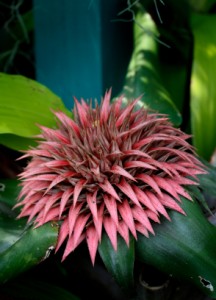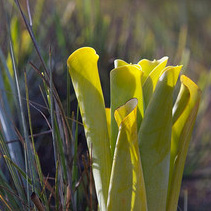Carnivorous Bromeliads
Author: Melanie Dearringer1 Comment

You may have heard of the Venus Fly Trap or the Pitcher plant, but did you know they are not the only plants that dine on bugs and other small prey? Most bromeliads have unique ways of absorbing nutrients other than through their roots, but there are three particularly special species of bromeliads that get their nutrients from living creatures. Brocchinia hechtioides, Brocchinia reducta and Catopsis berteroniana are the only three bromeliads that are specifically adapted to trapping insects and using them for nourishment.
Bromeliad Characteristics

-A Pink Spiky Bromeliad
Most bromeliads already have special adaptations for gathering nutrients. Many have leaves that fuse together to make a rosette shape that holds water in what is called a tank or urn. Trichomes, found on the leaves, take in the water and nutrients that comes from dust, leaves, plant matter and occasionally insects or droppings that fall into the tanks and decompose. While most bromeliads occasionally take in a few insects for nutrients they are not adapted to lure, trap and decompose the insects in the same ways B. hechtioides, B. reducta and C. berteroniana are. While the scientific community has been aware of these species for a long time it wasn’t until the 1980s that these three species were studied closely and observed consistently taking in insects at a much higher rate than other bromeliads suggesting that they are adapted to survive carnivorously.
Carnivorous Species Characteristics
According to Stewart McPherson, in an article for the Florida Council of Bromeliad Societies, B. hechtioides, B. reducta and C. berteroniana have several adaptations that allow them to attract, trap and break down the insects so that they can be used for energy and growth. The first is their conspicuous color. All three species are bright yellow and their rosette shaped leaves appear similar to flowers. This feature may attract insects initially. They also have a UV reflective powder coating their leaves. This powder is attractive to the insects that are sensitive to UV light. In addition, the plants seem to secrete a sweet scent that may be appealing to insects. Once they are drawn inside the plant’s water filled tank most insects are not able to get footing to climb out and drown in the water that is always stored within. The insects decompose and make a “nutrient soup” that the bromeliad takes in through the trichomes on its leaves.
Brocchinia
B. hectioides and B. reducta are slightly different in structure. B. reducta has leaves that curl together tightly to form a single deep tank with the leaves forming walls that are very vertical. B. hectiodes has several different tanks found in axils formed by more loosely connected leaves from which nutrients are drawn. Both B. hectioides and B. reducta appear differently in cultivation than when found on nature. Both Brocchinia species are terrestrial and at times even lithophytic plants meaning they grow either in soil or on bare rock and use their roots as anchors on the ground. They are adapted to live in sunny, barren habitats in South America, such as rocky plateaus where few other large plant species are found. They are most common in the Guiana highlands.
Catopsis
C. berteroniana appears more like B. hectioides with one significant difference. Like B. hectioides, C. berteroniana has loosely joined slippery leaves that form several tanks in the axils where the leaves join. The rainwater is collected in these tanks and it is here that the insects fall into the tanks because of the very slippery leaves. Unlike the Brocchinia, C. berteroniana is not terrestrial. It grows attached to trees. While the C. berteroniana has no official common name, it is often referred as the lampera de la selva meaning jungle lantern because of its bright yellow coloring and its placement high in the trees. This growth habit is not uncommon in the Bromeliad family, many species are epiphytes. However, C. berteroniana are most frequently found at the tops of trees above canopies or on branches with no leaves. Most other bromeliads prefer the environment underneath leaves and canopies because they collect the fallen tree mass such as leaves and twigs in their tanks. This mass is absorbed as they decompose and the plant uses them for nutrients. C. berteroniana’s adaptation to live high above the canopy is an indication that its primary nutrient source is something other than plant matter. It is most likely insects.
True Carnivores?
There is still some question and discussion as to whether or not these three species are truly carnivorous plants. Some argue that all bromeliads collect and absorb insects to some degree and there is no way to prove exactly how these three species trap and absorb insects. Others feel that because they appear to trap insects at a much higher rate than any other bromeliad these three species can and should be considered carnivorous plants.
More Species?
Stewart McPherson, in the same article referenced above, suggests that there may be even more species of Brocchinia that are carnivorous. He describes two taxa that are yet to be identified, which are very similar to the B. hectioides and B. reducta species, that are apparently getting their nutrients from insects. He feels that in the future these taxa may be classified as their own carnivorous species.
Cultivation
Brocchinia can be cultivated very similarly to many other bromeliads. They require a loose soil mix in a small pot, primarily to provide anchorage. Keep distilled water in the tanks to avoid saline buildup. According to Barry Rice, the plant’s foliage will maintain a dark green look and loosely, bowing foliage very similar to other bromeliads unless light conditions similar to their natural habitats are mimicked. Brocchinia thrive in the wild in almost constant bright, direct light and high heat conditions. If you have a space that can provide light and heat the Brocchinia reducta will appear bright yellow and the rosette will become more compact and erect creating a more interesting and unique bromeliad than one grown in conventional light conditions.
A Conversation Piece
If you would like a challenge and an interesting bromeliad to add to your collection consider cultivating a carnivorous Brocchinia. Even if you cannot provide an environment equal to their natural habitat they still are a beautiful bromeliad and excellent conversation piece. Growing a Brocchinia will be a fun way to display the vast diversity of the bromeliad family!
Sources
“Brocchinia reducta”. University of Connecticut Ecology and Evolutionary Plant Growth Facilities. <http://titanarum.uconn.edu/199600030.html>
McPherson, Stewart. “The Carniverous Bromeliads”. <http://fcbs.org/articles/The_Carnivorous_Bromeliads.htm>
Rice, Barry. “The Carnivorous Plant FAQ courtesy of The International Carnivorous Plant Society” <http://www.sarracenia.com/faq/faq5060.html>
Rice, Barry. “The Carnivorous Plant FAQ courtesy of The International Carnivorous Plant Society” <http://www.sarracenia.com/faq/faq5110.html>
Rice, Barry. “Brocchinia reducta Light Preferences”. <http://www.sarracenia.com/pubs/cpn38-10-11.pdf>
“The Genus Brocchinia”. The International Carnivorous Plant Society. <http://www.carnivorousplants.org/cp/Genera/Brocchinia.php>
Venus Fly Trap Photo credit: Babbagecabbage via http://www.flickr.com/photos/babbagecabbage/111218023/
Brocchinia Photo credit: Tony Nodine via http://www.flickr.com/photos/tonynodine/5622041557/
One response on “Carnivorous Bromeliads”
Leave a Reply

Resource Download
Hechtia Care Cheat Sheet
Learn how to care for your Hechtia bromeliad with this quick and easy informational guide.
Learn More
Ask an Expert
Questions about bromeliads?
Our experts love a challenge!
Photo of the Week
Submit your photo to be featured on the blog!
More Photo of the Week Winners
Submit Photo









do they need any fertilizer in central florida.